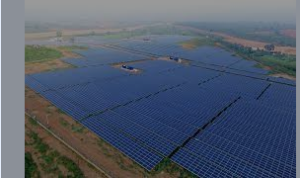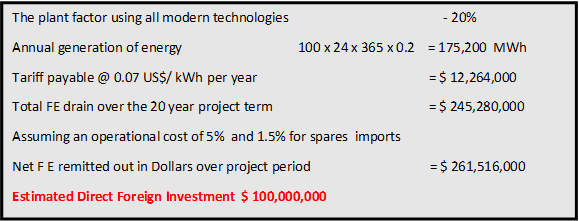Are we to buy our Solar Energy with Dollars?

Are we to buy our Solar Energy with Dollars?
Presidential Press release dated 13th June 2021 clearly defines the policy on our Energy Sector. The direction indicated is congruent with the presidential policy declaration “Vision for Prosperity and Splendor”. This is not a moment to vacillate and get embroiled in personal or political agendas. The situation in the country is much too precarious with the Covid 19 raging and the spectra of the impact of Climate Change haunting us. The foreign reserves are falling impacting the rupee and the cost of living. The agitation and indiscipline on the streets in the midst of a Pandemic are signs of the social and economic instability creeping in. Sri Lanka can overcome the crisis but it needs sound leadership to mobilize and motivate the people to utilize its own resources in a prudent and fair manner.
A country endowed with talented and educated human resources, abundant sun, wind, fertile soil and water. All these are valuable assets when it comes to opting to renewable energy. Renewable energy will not bring millions to individual businessmen but will give them sound incomes. However, a very large number of people will be become prosumers, that is those actively contributing to producing energy and at the same time using the generated energy themselves. The excess will be sold to the national grid s already practiced by the Solar Roof Top systems.
In this way, the country will save a large amount of foreign exchange, the environment will benefit as no fossil will be used and the consumers will benefit as they will be also producers and earning money as a result. There will also be a change in the economic scenario as power generation will be decentralized. The character of the Ceylon Electricity Board will be totally changed from being a loss making “Colossus” to becoming a sophisticated research and development unit servicing the entire country with training and back up facilities. Singapore has very successfully graduated to this system.
His Excellency The President in a recent progress review meeting left no room for the interpretation of his Policy Target of reaching 70% of Renewable Energy for Electricity Generation by 2030 (unfortunately diluted down from the original 80% RE) that his vision is for Renewable Energy and there should be no attempts to misinterpret this by calls for so called “Clean Energy”. There is no such clean energy outside the realm of renewable energy and no fossil fuel can be given that distinction.
This national target has to be formalized now by a cabinet decision and gazetted; otherwise, the President’s policy could very well be surreptitiously overturned.
Pursuing this goal, the contributions of various forms of indigenous sources of renewable energy have to be harnessed. Of these Solar Energy holds pride of place with the progress made in recent years, particularly by Roof Top Solar PV systems , aided by the most visionary provision of the Surya Bala Sangraamaya” which has to date reached a level of over 350 MW installed and many more in stages of implementation. The most challenging target set by the President however, would call for development of other larger installations both ground mounted and floating in the coming years.
The Ministry as well as the CEB have been working on several such projects with 100 MW Solar Park in Siyambaladuwa for which the required land has already been ear marked and a proposed 150 MW Solar park in Pooneryn to follow shortly.
It is under these circumstances that I am compelled to raise alarm bells as noted in the title of this Paper. Are we to buy our Solar Energy in Dollars?
A Fresh Look at Solar Energy
Devoid of preconceptions and bias for and against.
I published the above article in the Island newspaper (https://island.lk/devoid-of-preconceptions-and-bias-for-and-against/) some months back high lighting the many aspects of this most valuable resources, that mother nature has endowed on us in Sri Lanka and the need for most careful plans and programs to gain the best advantage to Sri Lanka ,
The objective should be broader than the mere addition of energy to the grid. The Solar Energy opens up the potential for making the energy sector an indigenous industry. This would contribute to the national economy much more than what is given by the amount of electricity generated, by way of high level employment, development of local entrepreneurs and possibility of upstream and downstream integration not to mention the savings in foreign exchange.
With the current moves to move forward with the 100 MW Solar Park in Siyambaladuwa, it is most important that the other relevant issues are given due consideration.
Looking at the larger picture
His Excellency’s goal of 80 RE as expressed in the Vision for Prosperity and Splendour” is based on a number of far reaching concepts. The reduction of Sri Lanka’s dependence on imported fossil fuels and thereby the future energy security, is the most apparent and noteworthy goal. But along with it should come the additional spin off benefits which would accrue, whether specifically stated or not. Only by ensuring these spin off benefits, also derived by strategic actions in reaching the primary goal, that the “Splendour” of the vision would be achieved.
I am repeating here these important principles which should not be lost sight of at this critical juncture, and the opportunity be lost forever. These principles which would ensure that Sri Lanka truly achieves future energy security and the additional advantages are
- The energy industry must at least now strive to become a National Industry. The competency of our entrepreneurs and technologists to achieve this already well proven in the Renewable Energy Sector of Solar, Wind and Mini Hydro development where they have even succeeded in penetrating foreign markets. The success of one of our largest indigenous energy company in the developing large projects overseas, of capacity many hundred megawatts, albeit in the fossil fuel field, nevertheless adds further confidence on our competence.
- The entrepreneurship in energy sector should be viewed as a major potential contributor to the growth of the GDP, not a mere service in ensuring the energy supply for other sectors in the economy to grow.
- The development of Renewable Energy resources and services is a significant avenue of developing employment opportunities, particularly in the higher technical levels
- A most important aspect of the vision to reach the 80% RE target is the reduction of the drain on foreign exchange by the continued use of imported fossil fuels. Even in the case of LNG, such imports at ever increasing costs, will have to be incurred in the foreseeable future.
- In case of bio energy the added advantage of multiple spin off benefits to the rural economy and many other sectors is possible as already proven in the few projects developed. The added advantage being a source of firm power, with no drain of foreign exchange
The feasibility of achieving all of the above laudable principles is already proven in the Roof Top solar industry and to a limited extent in the other sectors of RE.
The challenge now is to ensure that the adherence to these principles to be held as sacrosanct in the efforts to develop the larger solar and wind projects in the pipe line.
The Pitfalls to be avoided.
I am addressing these remarks on the Siyambaladuwa 100 MW solar project in particular, but similar consideration must be given for any other such solar and wind projects too.
The desire for the CEB to have large power plants in one location is acceptable from their point of view. It may also be considered favorable for Wind and Solar projects, to keep the option of enhancing them to be dispatchable firm power projects, with the addition of battery storage. However, both Wind and Solar Projects have the advantage that any size of project conceived however large, consists of a large number of solar panels currently reaching over 500 watts per panel and a discrete number of wind generators, which too have now reached capacities of 5 MW each. While such growth of individual unit capacities have added to the increasing viability and economy of the projects, the fact remains that even a single solar panel or a wind tower is technically feasible. Therefore, the packaging of the number of individual units for a particular project is made purely on economic considerations.
What is important to realize is that such considerations must take into account, the principles outlined above to gain the greatest advantage to the country, which unfortunately seems to be glossed over by the planners, for various reasons. A holistic view in a national perspective would highlight the immense direct financial value and other economic and social benefits and energy security on one hand and the potential dangers in overlooking these on the other hand.
Let us look at the Siyanbaladuwa project as the example before any unwise decisions are made.
The project capacity – 100 MW installed
Targeted Grid Substation – Moneragala
Land Acquisition – Already made
Current Proposal – 4 packages of 25 MW
Sri Lankan entrepreneurs and engineers have already proven their capacity of developing projects up to 10 MW, an upper limit imposed by administrative strictures and not on any technical or financial grounds.
Therefore the logical policy should be to plan this project to be awarded to ten local entrepreneurs, to handle packages of 10 MW, properly structured and managed by the CEB, on National Competitive Bidding, so that the tariff would be in Sri Lanka rupee terms, without any linkage to any foreign currency considering that we don’t have to import or pay for our sunshine. And there would be no drain on foreign exchange except for the initial one time expenditure on import of the necessary equipment and a limited amount for any minimal spares imports only. The local entrepreneurs and the lending institutions and even the smaller investors in the stock exchange have shown their eagerness to contribute to this form of national venture. So there is no validity in any argument on the availability of funds or the technical capabilities.
The alternative would be to invite foreign participation , usually couched in arguments of lack of adequate expertise , which as shown above are not tenable in the present situation, and the lure of so called “ Foreign Direct Investment “ and inward flow of Dollars at this critical juncture. But the question must be asked is, in how many such projects approved by the BOI, how much funds were sourced from the local banks limiting the credit available for the local entrepreneurs. The most blatant example is the Korean Investor in the Thulhiriya Textile Mill, who vanished leaving a multibillion loan unsettled for a local bank.
In the present situation the conditions are even worse. Let us assume that the investor would bring in the total capital required. Which may be assumed as US $ 100 Million for the 100 MW by one or more foreign investors. It is clear that they would have the advantage of the currently depleted cost of funds in the global market, which is not available for the local competitors in an open international tender. However, it is certain that the foreign investor in exchange would demand a Dollar Linked Tariff. Using an estimated final tariff of US $ 0.07/kWh, the following interesting numbers emerge.

So against a dubious inflow of $ 100 Million we would be sending out 260 % , all of which other than the initial capital could have been retained in Sri Lanka. Moreover, with the ever depreciating rupees, this amount of dollar would be costing us much more in rupee terms. Let us be generous to assume that the foreign investors would accept a tariff in dollar terms. Using a mere 3% depreciation of the rupee this drain would amount to a colossal Rupees 67.5 Billions over the 20 year project life.
The added exchange used for import of spares during the 20 year period would be $ 30 Million or Rs 8.7 Billion leading to a total drain in foreign exchange of Rs 75.8 Billion
Against this, for an initial foreign exchange cost of US $ 80,000,000 for a group of local companies the entire expenditure over the project period would be Initial capital on US$ . 80,000,000 x 202 = Rs 16.16 Billion Import component of spares during project period @ 1.5 % of capital per year = Rs 6.9 Billion
If this is also adjusted @ 3% Depreciation per year leading to a total foreign exchange drain of Rs 23.06 Billion only, against the Rs 75.8 Billion mentioned above.
These differences are illustrated in the chart below.


The amount that would have been spent on import of oil to generate the equivalent amount of energy would be, once more assuming the price of crude oil will remain at $ 70.00 level for now the current FE cost of the oil used for power generation is about ( @ 0.28 l/kWh costing $ 0.58/l) )
Therefore for a 100 MW oil Power Plant per year the fuel cost would be
= 175,200 x 1000 kWh X $ 0.28 l/kWh x 0.58 $/kWh = $ 28.5 Million per year
The initial FE expenditure on import of the equipment would be saved in less than three years by eliminating the fuel cost alone of the equivalent oil power plant.
Total Savings during the 20 year project life – $ 560 Million
While we can save this total amount by using local entrepreneurs we will send back half of this saving if foreign parties are used.
Most importantly this huge amount of money would remain in Sri Lanka and result in much economic multiplier effects.
A likely argument in support of using foreign investors would be that at this moment Sri Lanka could ill afford spending even the initial $ 80 Million. However, there are many Green Funds which Sri Lanka has done to little exploit such as the Green Carbon Fund which can be approached for very attractive funding mechanisms or even the ADB for a project of this nature.
A further option to further improve this balance sheet is to take advantage of the fresh interest in Carbon Credits. With USA back in the Climate Change discussions there is the possibility of improved avenues of monetizing the undoubted carbon emission reduction ( CER) potential of this project. The estimated CERs annually form the 100 MW solar project is 175200 X 0.72 = 126,144 Tons of carbon equivalent.
This is the basis of my question in the title of this article. We will by spending in Dollars for the use of our own Solar Shine, which we could harness ourselves for a similar or lower cost in rupees and also ensure the much desired energy security and reduction of drain on foreign exchange.
The folly of a similar nature was permitted during the Mahaweli Project downstream development. The project packaging was done in a manner to exclude the local contractors and the awards were made to foreign companies. However the actual work was done by local contractors on sub contracts very competently. But their experience still remains unaccepted for prequalification of the larger scale of projects. Many decades after, such monumental follies need not be repeated. Let us remind ourselves not to “ රෑ වැටුණු වලේ දවල් නොවැවෙමු”

Eng. Parakrama Jayasinghe
Council member
Bio Energy Association of Sri Lanka
E Mail: parajayasinghe@gmail.com
27th July 2021

Leave a Reply